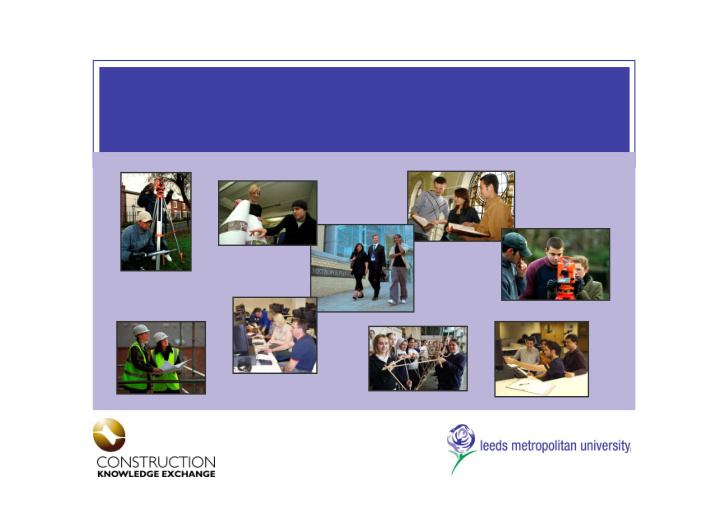



Dr Vicky Hutchinson Leeds Metropolitan University, UK Industry-HEI engagement through a knowledge exchange: Issues emerging
Presentation overview • Introduction: Drivers of knowledge exchange • Construction Knowledge Exchange: – Aims & activities – Research methods/ evidence base – Results – Propose a more sophisticated evaluation framework • Two paradigms of knowledge • Implications for CKE
Drivers of knowledge exchange • Government perceives UK science base as second only to US, in global terms • ‘Third leg’ funds supporting exploitation of HEI specialist knowledge • All organisations to increase, and demonstrate, the economic and social impact of investment in the knowledge base • Construction has much to gain
Construction Knowledge Exchange Aims • Supports teaching & learning by enabling knowledge flow into partner universities from industry • Supports industry by enabling knowledge flow out from universities to business
Construction Knowledge Exchange: Activities • Collaborative research • Assist SMEs in innovation projects • Staff secondments into & • Enterprise consultancy out of HEI agreements • Establish Innovation • Enterprise awareness Circles events for HEI staff • Industry/HEI forums • Training in enterprise for HEI staff
Research methods/ Evidence base • Signed forms document the activities and provide some initial evaluation • Business Assists – tick-box questionnaires • Innovation Circles – more qualitative evidence
Business Assist Results: Business assistance ratings � Positive results? 15.5% - ‘Excellent’ � Lack of response? 12.1% - ‘Very Good’ � Meaning? 15.5% - ‘Good’ 1.7% - ‘Fair’ 0% - ‘Poor’ 55.2% - no response
Business Assist Results: Effect on role in the workplace • 32.8% of people reported the assistance would affect their role at work • 60.3% of people did not respond to the question
Innovation Circle Results: Case Study (Description) Management Services division of a large, multidisciplinary engineering practice “Participant A had reviewed other process tools as potential vehicles for the system. Currently all have been dismissed apart from x , as this seems to be the only tool able to perform fundamental tasks. Participant A is seeking technical support from Microsoft to confirm that other software cannot perform these tasks, thus ruling them out. She also compiled a successful bid for new work.”
Innovation Circle Results: Case Study (Evaluation) Assistant Business Development Manager: “Facilitated by the Innovation Circle, we’ve delivered the System on time and it has been well received. The Innovation Circle was a useful way of maintaining the momentum of the task. Having a facilitator helps focus the mind and the action points provided structure. It was a good discipline to have.”
Methodological issues arising To better understand whether what we’re doing is effective, we can examine the rationale for doing it. – Why ought it to work? – How should it work? – How is it working in practice ?
Evaluation: a possible framework • Scientific paradigm of knowledge – Knowledge “is a reified object, capable of being packaged up, owned and passed around” (Hall and Quintas, 2003) • Social Constructionist paradigm of knowledge – Knowledge, or ‘knowing’, is conceptualised as a social process; knowledge ‘transfer’ is conceptualised as ‘sharing’ (McAdam and McCreedy, 2000; Hall and Quintas, 2003)
By extension: • Within scientific paradigm, broadcast tools and techniques suitable for KE. Narrowcast techniques are suitable, but cost effectiveness questionable • Within social constructionist paradigm, broadcast tools unsuitable for KE; narrowcast techniques enable genuine learning with substantial impact
Implications for CKE: • Re-examination of aims & objectives of CKE • Development of new ways of demonstrating the extent of KT during an ‘event’ (& substantiating the role of the CKE in fostering business improvement through Innovation Circle) • As KE practices mature, anticipate pressure to extrapolate to generate testable hypotheses and generic theories of KE
Recommend
More recommend